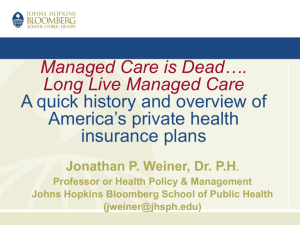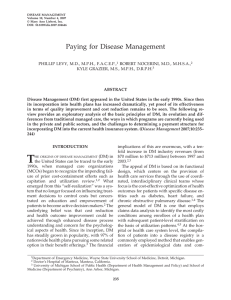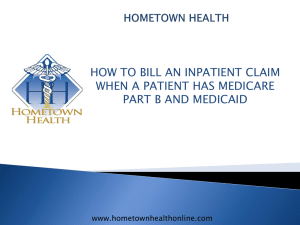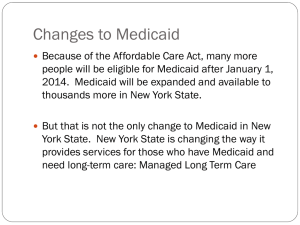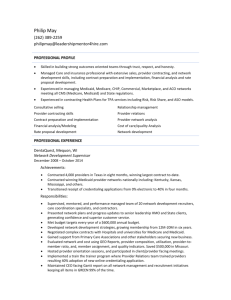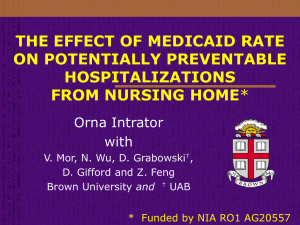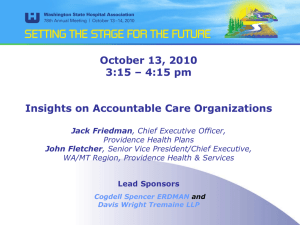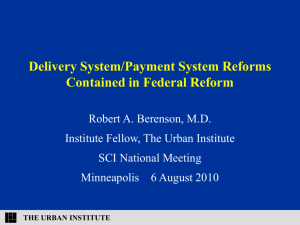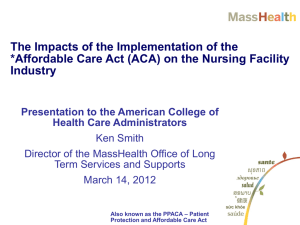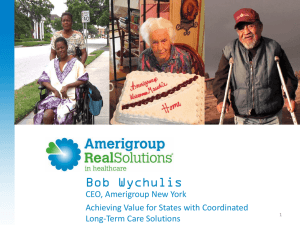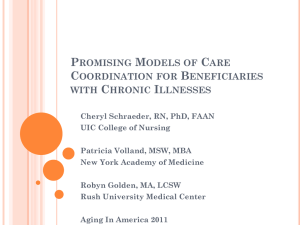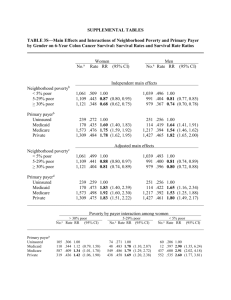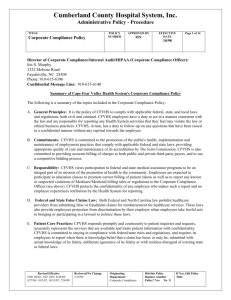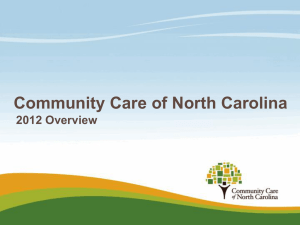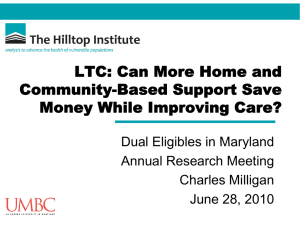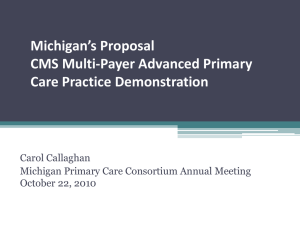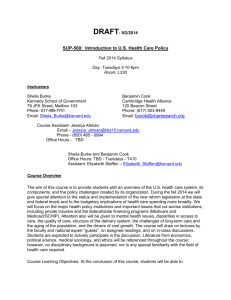Robert J. Master
advertisement
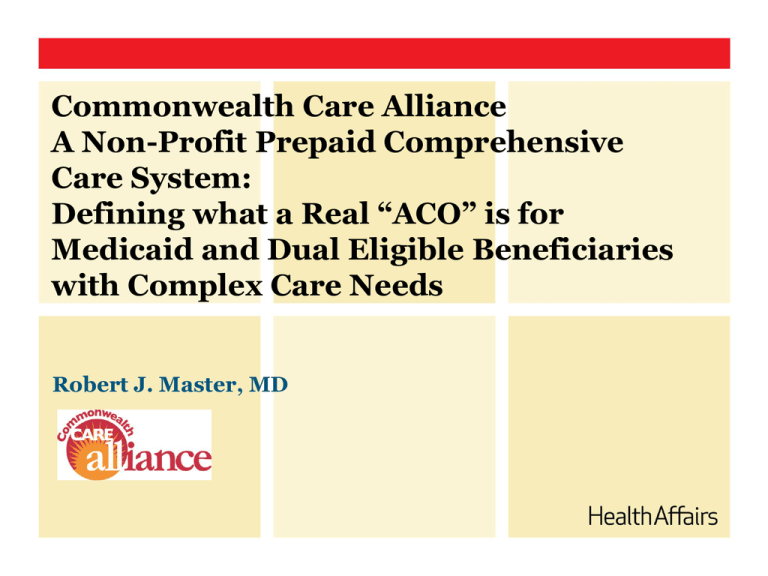
Commonwealth Care Alliance A Non-Profit Prepaid Comprehensive Care System: Defining what a Real “ACO” is for Medicaid and Dual Eligible Beneficiaries with Complex Care Needs Robert J. Master, MD Case Vignettes • Mattie H. - A fiercely independent 77 y.o. woman living alone with longstanding Diabetes and Hypertension. Three recent strokes caused left side weakness and requirements for significant personal assistance to maintain independence. Mobility limitations impeded access of medical care during the 9 months before enrollment. Increasing depression, withdrawal and erratic nutritional intake ensued. There were frequent falls and multiple hospitalizations for poorly controlled Diabetes, dehydration, urinary tract infections and pressure sores Nursing home placement, was recommended. • Anna C. - A 55-year-old woman with long standing Multiple Sclerosis with secondary partial paralysis in all extremities and urinary retention requiring frequent daily self catheterizations. There was a long standing history of depression, one prior major suicide attempt, and a history of alcohol abuse and heavy cigarette use as well. During the past few years there has been multiple hospitalizations for urinary tract infections, respiratory infections and asthma exacerbations. No consistent primary care or behavioral health relationship has ever been established. In CY2010 CCA managed about $175M in risk adjusted Medicare and Medicaid premiums to provide the totality of benefits to the following populations Population # Enrollees Characteristics Dual Seniors 2961 68% nursing home certifiable (functionally homebound) Average Medicare RS=1.9 70% from communities experiencing disparities 56% Diabetes, 23% CHF 6% annual mortality Ave. risk adjusted Medicare/Medicaid premium $4100 PMPM Medicaid Adults with complex care needs (CCN) 2410 Multiple Adults with severe physical disabilities 270 defined chronic illnesses Concurrent active MH/SA issues Medicaid’s “12/60” population Coordination needs high, “engagement” low Ave. risk adjusted Medicaid premium, $1800 PMPM SCI, Cerebral palsy, Spina Bifida, Advanced degenerative neurologic disease (e.g. MD, MS) Require 65+ hours of PCA services a week to live independently Meaningful primary care, previously rare to non existent Average risk adjusted premium $5200 PMPM (excludes PCA services) Primary Care Redesign 25 Primary care practices including FQHC’s in 8 fully contracted hospital systems primary care financial investment – ($130 - $400 PMPM) Integrated multidisciplinary clinical teams, stratified to need; nearly 100 clinicians integrating in practices with IT, management, and infrastructure support Population Primary Care Redesign Homebound Seniors RNP’s, RN’s 1:45, Geriatric SW’s 1:80, integrated BH, PH, Palliative care clinicians Medicaid “CCN” population RNP 1:80 MH professional (e.g. LICSW) 1:200 CHW’s 1:120 Tracking, coaching, surveillance, infrastructure Adults with Severe Physical Disabilities RNP SW MH professional PT DME Coordinator 1:40 1:100 1:200 1:80 1:100 Multidisciplinary Clinical Teams with “Shared Decision Making”: Primary Care Redesign Elements Enhanced Primary Care comprehensiveness of intake assessments (multiple dimensions not just medical). Individualized Care Plans (well beyond “problem lists”). Same day, episodic care response capabilities (particularly in home settings). 24/7 with EMR support. Integrated palliative care and behavioral health clinicians. Continuity clinical management in all settings and through all “transitions”. Care Coordination Ability to order, authorize and connect to all medical, BH, DME, therapy and LTC services (“The teams own the checkbook”). Resource allocations with contracted network via decision support tools. RESULTS Senior Care Options Utilization •Homebound elders 17,061 PC visits/K/Yr.* mostly in home; Ambulatory elders 11,263 visits/K/Yr. (Medicare FFS Ave, 7200 visits/1000 Yr.) – MedPac •Hospital use, 1995 days/K/Yr. (Ave RS 1.98), 55% Medicare risk adjusted FFS Ave. •“NHC” nursing facility placements 36% of FFS Medicaid benchmarks (Mass. JEN Study) Quality •HEDIS 90+ percentile, comprehensive Diabetes care, monitoring patients on persistent medication, access to preventive health services. •50% in CHF hospital admissions (40.3 Adm/K/Yr. – 23% CHF prevalence) vs. MA Statewide Medicare FFS benchmark. Cost •2004-2010 average annual medical expenditures increase 2.2% •Average MER 2004-2010 - 84% Disability Care Program •Exceedingly high member satisfaction – external survey. •Hospital admissions, expenditures, reduced 70% compared to Medicaid FFS experience. •50% reduction in hospitalizations for pressure sores (prior studies) •Total medical expense 80% of risk adjusted premiums. Summary Problem Opportunity Inadequate, discontinuous, unengaged Primary Care Team approach – RN/RNP/SW/BH/PCP Horizontal rather than vertical MD relationship Inappropriate dependence upon Emergency Rooms for sick/nonemergent issues 24/7 telephonic access to care team, supported by member’s clinical record to inform clinical triage and decision making Difficulty of getting to physician offices/clinics for care; Inability of physician to assess home environment Capacity for home visits and transfer of clinical decisions to the home or other care settings as necessary; full “picture” of needs Traditional “disempowered role” of member in the relationship with busy physicians Meaningful consumer involvement in care management and care design Fragmented relationships with specialists, hospital and institutional providers Coherent and fully organized hospital, institutional and specialist network centered around the primary care physician and team Insurance company “rules” regarding benefit requirements and service authorization Fully empowered Primary Care Team able to order/authorize all needed services Lack of continuity and shared information among medical, behavioral health and long term care providers Fully integrated network of all providers and the Primary Care Team as the “hub” of the wheel to promote information sharing and care transitions Incoherent “picture” of totality of member’s medical, behavioral health and support service needs Fully integrated clinical record and state of the art data support Medicaid’s inability to “individualize” community based support care needs. “Costs without Benefit” PCA’s and community based LTC services allocated clinically as part of individualized care plan



